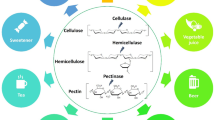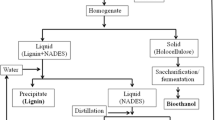Abstract
Current technology for conversion of biomass to ethanol is an enzyme-based biochemical process. In bioethanol production, achieving high sugar yield at high solid loading in enzymatic hydrolysis step is important from both technical and economic viewpoints. Enzymatic hydrolysis of cellulosic substrates is affected by many parameters, including an unexplained behavior that the glucan digestibility of substrates by cellulase decreased under high solid loadings. A comprehensive study was conducted to investigate this phenomenon by using Spezyme CP and Avicel as model cellulase and cellulose substrate, respectively. The hydrolytic properties of the cellulase under different substrate concentrations at a fixed enzyme-to-substrate ratio were characterized. The results indicate that decreased sugar yield is neither due to the loss of enzyme activity at a high substrate concentration nor due to the higher end-product inhibition. The cellulase adsorption kinetics and isotherm studies indicated that a decline in the binding capacity of cellulase may explain the long-observed but little-understood phenomenon of a lower substrate digestibility with increased substrate concentration. The mechanism how the enzyme adsorption properties changed at high substrate concentration was also discussed in the context of exploring the improvement of the cellulase-binding capacity at high substrate loading.






Similar content being viewed by others
References
Himmel, M. E., Ding, S. Y., Johnson, D. K., Adney, W. S., Nimlos, M. R., Brady, J. W., et al. (2007). Science, 315, 804–807.
Van, D. B. (1972). Ph.D dissertation. Massachusetts Institute of Technology.
Howell, J., & Stuck, J. (1975). Biotechnology and Bioengineering, 17, 873–893.
Liaw, E. T., & Penner, M. H. (1990). Applied and Environmental Microbiology, 56, 2311–2318.
Lee, Y. H., & Fan, L. T. (1982). Biotechnology and Bioengineering, 24, 2383–2406.
Ryu, D. D. Y., & Lee, S. B. (1986). Chemical Engineering Communications, 45, 119–134.
Huang, X. L., & Penner, M. H. (1991). Journal of Agricultural and Food Chemistry, 39, 2096–2100.
Miller, G. (1959). Analytical Chemistry, 31, 426–428.
Sluiter, A., Hames, B., Ruiz, R., Scarlata, C., Sluiter, J., Templeton, D., et al. (2004). Laboratory Analytical Procedure (LAP). Golden: National Renewable Energy Laboratory.
Beldman, G., Voragen, A., Rombouts, F., Searle-van, L. M., & Pilnik, W. (1987). Biotechnology and Bioengineering, 30, 251–257.
Kyriacou, A., Neufeld, C., & Ronald, J. (1988). Enzyme and Microbial Technology, 10, 675–681.
Nidetzky, B., Steiner, W., & Claeyssens, M. (1994). Biochemical Journal, 303, 817–823.
Holtzapple, M., Cognata, M., Shu, Y., & Hendrickson, C. (1990). Biotechnology and Bioengineering, 36, 275–287.
Tengborg, C., Galbe, M., & Zacchi, G. (2001). Enzyme and Microbial Technology, 28, 835–844.
Grous, W., Converse, A., Grethlein, H., & Lynd, L. (1985). Biotechnology and Bioengineering, 27, 463–470.
Gong, C., Ladisch, M., & Tsao, G. (1977). Biotechnology and Bioengineering, 19, 959–981.
Ladisch, M., Gong, C., & Tsao, G. (1980). Biotechnology and Bioengineering, 22, 1107–1126.
Xiao, Z., Zhang, X., Gregg, D., & Saddler, J. (2004). Applied Biochemistry and Biotechnology, 115, 1115–1126.
Kristensen, J., Felby, C., & Jørgensen, H. (2009). Biotechnology for Biofuels, 2, 11–20.
Medve, J., Karlsson, J., Lee, D., & Tjerneld, F. (1998). Biotechnology and Bioengineering, 59, 621–634.
Jervis, E., Haynes, C., & Kilburn, D. (1997). Journal of Biological Chemistry, 272, 24016–24023.
Acknowledgment
The authors wish to acknowledge the financial support provided by Masada Oxynol, LLC, Alabama Center for Pulp and Bioresource Engineering, Laboratory of Biofuels and Biomaterials, Auburn University.
Author information
Authors and Affiliations
Corresponding author
Rights and permissions
About this article
Cite this article
Wang, W., Kang, L., Wei, H. et al. Study on the Decreased Sugar Yield in Enzymatic Hydrolysis of Cellulosic Substrate at High Solid Loading. Appl Biochem Biotechnol 164, 1139–1149 (2011). https://doi.org/10.1007/s12010-011-9200-8
Received:
Accepted:
Published:
Issue Date:
DOI: https://doi.org/10.1007/s12010-011-9200-8




